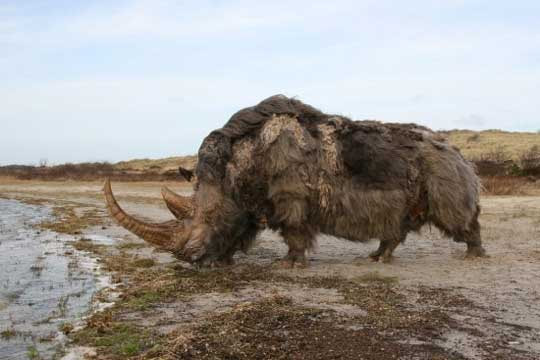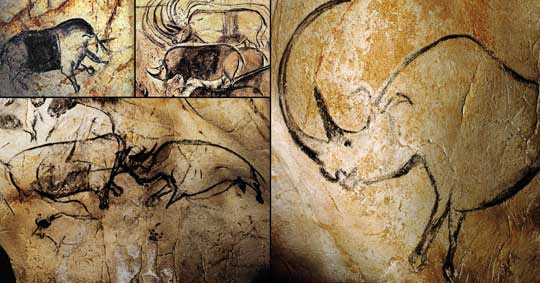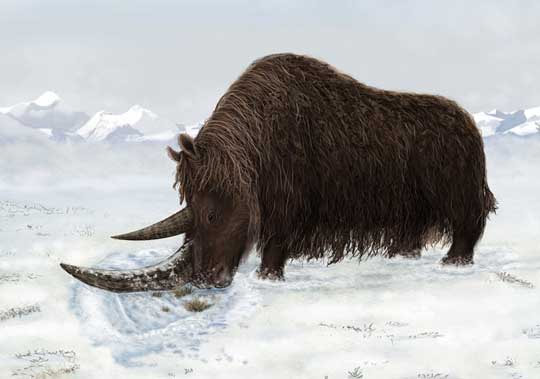|
My new Across Horizons series features many fascinating creatures (some of them scary, some not so much). One animal that makes several important appearances in the first book (titled Obsolete Theorem) is the Woolly Rhinoceros. The woolly rhino, now extinct, is one of those iconic Ice Age creatures, along with such animals as the woolly mammoth, the cave bear, and the saber-toothed cats. What the heck is a Woolly Rhinoceros? First, the woolly rhino (Coelodonta antiquitatis) was... well, woolly. It had a long, thick coat of fur to help it stay warm in a freezing climate. Woolly rhinos stood about 6.5 feet (1.98 m) high at the shoulder. This is taller than most humans and about the size of the modern white rhinoceros. They weighed up to 6,000 pounds (2,721 kg) and were about 12.5 feet (3.8 m) long. Woolly rhinos lived throughout Europe and northern Asia, and they existed from about 350,000 years ago to the end of the last ice age, about 10,000 years ago. Amazing facts about the Woolly Rhinoceros The woolly rhino had the widest range of any rhinoceros species. It lived in most of the areas where woolly mammoths lived... except for North America. For some reason, woolly rhinos did not cross the Bering land bridge, although no one seems to know exactly why. I suppose it's possible that a few woolly rhinos made it to North America, but since no remains have been found, there must not have been very many that made it. Some scientists suggest that woolly rhinos didn't cross the land bridge because they could not survive in a tundra environment. Woolly rhinos had two horns, and the horn on the end of their snout was really long, up to 4.6 feet (1.4 m). This long horn faced forward more than the horns of modern rhinos. Why? It is thought that woolly rhinos used their long horns like a snow shovel, scooping deep snow to the sides so they could eat the plants beneath it. By the way, rhinoceros horns are made of keratin, the same substance that makes up hair, fingernails, claws, feathers, hooves, calluses, and the outer layer of skin of many animals. Because these horns are made of keratin, and they do not have a bony core like the horns of some animals, rhino horns do not fossilize. So, if the horns didn't fossilize, how do we know what the horns looked like? Because some woolly rhinos have been found that were preserved in permafrost (soil that is permanently frozen throughout the year). And since woolly rhinos existed relatively recently (10,000 years ago is VERY recent by evolutionary standards), some of these frozen horns are still intact (not fossilized... just frozen). Below is an amazingly well preserved woolly rhino found by gold miners in Siberia in 2007. It died and became permanently frozen about 39,000 years ago, which happens to be fairly close to when Skyra lived. Notice that much of the fur is missing, except on parts of the legs and head. Perhaps an even more remarkable find is Sasha. Sasha is a juvenile woolly rhino found in 2014 (also in Siberia), and in this case nearly all of the fur was intact. Scientists carefully cleaned the 34,000-year-old skin and fur and arranged it in standing pose to show what the creature looked like in life. Kind of cute, huh? Ancient humans were apparently impressed by woolly rhinos. Images of these creatures are found among numerous cave paintings. Perhaps the most impressive set of cave painting ever found is the Chauvet Cave in southern France. This cave wasn't discovered until 1994, and it is packed with spectacular paintings that have been dated at 30,000 to 33,000 years old. Among the most common animals depicted—the woolly rhino. Hmm... these cave paintings stimulate the imagination, don't they? Why did these people 30,000 years ago paint animals on cave walls? This is an interesting question, but the problem is, these people are long gone and we know nothing about their culture and the way they thought about things. So, all we can really do is guess. When someone painted a woolly rhino, were they simply painting the animal they liked to hunt and eat? Or perhaps they were painting a supernatural spirit? Or maybe they were depicting a family member whose soul they believed now exists in the form of an animal. Perhaps the cave could have even been a classroom, in which the children were encouraged to draw whatever came to their minds at the time. I guess we'll never know, will we? Another thing we may never know for sure is how frequently humans (and Neanderthals) hunted woolly rhinos. Rhino bones have been found alongside human bones in caves, but these particular caves were not natural habitats for either the humans or the rhinos. This suggests that other animals, such as hyenas, may have dragged the bones into these caves. Some weapons and tools were made with rhino bones, but these could have been bones from carcasses the humans found. Perhaps the best evidence we have is rhino bones that have marks likely caused by human tools or weapons (some caused by a sharp object, maybe a spear). Anyway, I'm pretty sure that when humans or Neanderthals encountered a woolly rhino, it was a rather exciting event. Check out this video of a Neanderthal/woolly rhino encounter. So, the Woolly Rhinoceros deserves a place in the H.A.H.O.F. (Humdinger Animal Hall of Fame). FUN FACT: The first documented use of the word humdinger was in 1883. It is considered an Americanism, and it refers to something or someone truly remarkable (The mayor gave a humdinger of a speech). The word may have originated by combining hummer and dinger, both of which were used to refer to something exceptional. Humdinger is also often used to describe something that is large (It was a humdinger of a storm), which makes this word particularly suited for the woolly rhino. So, humdinger is another way to say awesome! Photo Credits:
Woolly rhino #1 - ExtinctAnimals.org Woolly rhino size comparison chart - Prehistoric Fauna Well-preserved woolly rhino - Vladimir Filippov via Twitter Sasha the baby woolly rhino - Siberian Times Chauvet Cave paintings - The Bradshaw Foundation Last Woolly rhino image - CBS News
0 Comments
Leave a Reply. |
Stan's Cogitations
Everyone needs a creative outlet. That's why I write. Archives
July 2024
|







 RSS Feed
RSS Feed